Are you thinking of welcoming a Rottweiler into your family? Well, you’re in for a treat. These affable, intelligent, and courageous dogs make great companions. But there’s more to this breed than you might initially realize.
Originally developed in Germany to herd livestock and pull carts, Rottweilers have a rich history that’s just as robust as their physique.
What to Expect: The Basics
- Temperament: Affectionate, Good-Natured, Confident
- Lifespan: 8-10 years
- Height: Male: 61–69 cm, Female: 56–63 cm
- Weight: Male: 43–59 kg, Female: 38–52 kg
With their powerful stature and distinctive black-and-tan coloring, Rottweilers are often considered intimidating. However, if you get to know them, you’ll find they have a tender heart and a deep-rooted loyalty to their families.
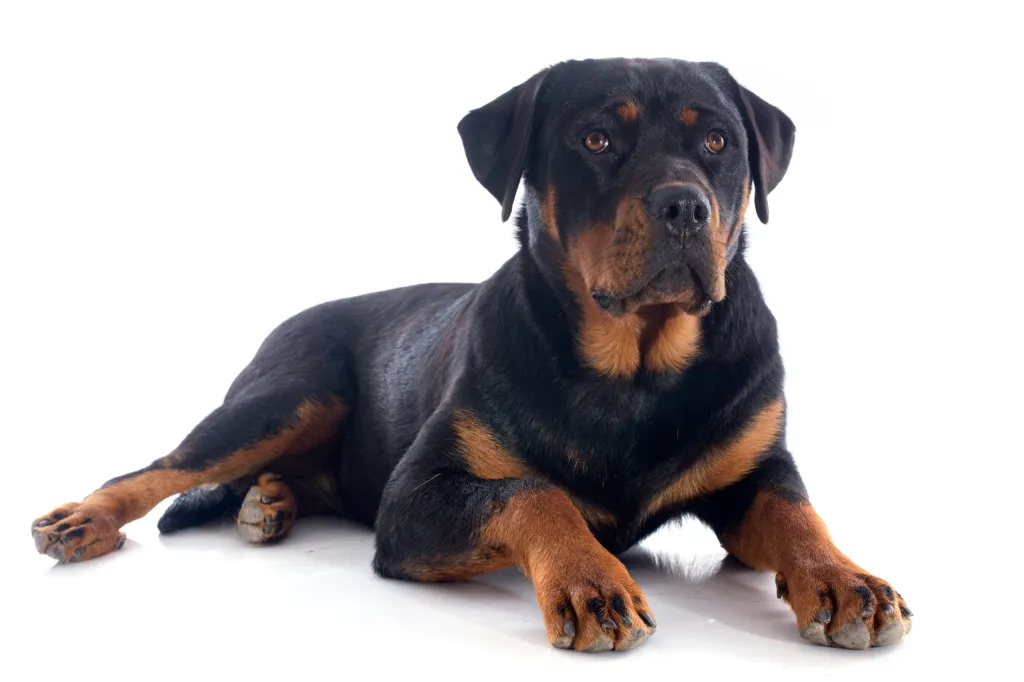
Underneath the exterior, Rottweilers are surprisingly versatile. They’ve been involved in search and rescue, police work, and even therapy. Their versatility and love for their humans are what make this breed truly special.
Ready to dig deeper? Sit back and enjoy this comprehensive guide, bubbling with insight about the Rottweiler breed.
The Rottweiler, a large, powerful dog breed, hails from Rottweil, Germany. Their impressive lineage dates back to the Roman Empire. These days, they’re appreciated for their versatility, serving roles like police dogs, search and rescue, and service dogs. They’re muscular with broad heads, sporting a unique short, dense black and tan coat.
Despite their robust build, Rottweilers carry a calm and confident presence. They’re known to be gentle and loving towards their families if adequately trained and socialized from a young age. Their loyalty and protective instinct mark them as natural home guardians. They may be a bit shy around strangers, but their good-natured disposition means they love being around their human friends. To ensure they grow up to be both cuddly pets and efficient working dogs, Rottweilers need consistent training, early socialization, and plenty of exercise.
If you’re mulling over the idea of adding a Rottweiler to your family, pause to consider the possibility of adopting from rescue centers or shelters to give a needy dog a loving home. Should you choose to buy a Rottweiler puppy, make sure you pick a recognized breeder. A credible breeder prioritizes their dogs’ health and temperament, ensures the pups undergo health screenings and nurtures the puppies well. This way, we contribute to discouraging unscrupulous breeding practices while ensuring that you take home a robust and cheerful puppy.
Quick Facts
- Origin: Germany
- Size: Large
- Breed Group: Working
- Lifespan: 8 to 10 years
- Coat: Rottweilers have a short, dense, and double-coated fur. Their coloration is usually black with tan markings.
- Temperament: Rottweilers possess loyalty, confidence, and a protective nature. They display affection and gentleness towards their family while maintaining wariness around strangers due to their strong guarding instinct.
- Exercise Needs: Rottweilers are active dogs requiring regular exercise for both physical and mental well-being. Daily walks, playtime, and mental stimulation are beneficial.
- Training: Training Rottweilers is effective with consistent, positive methods. Early socialization and obedience training are crucial for fostering good behavior and manners.
- Grooming: Rottweilers have a short coat that demands minimal grooming. Regular brushing promotes coat health and helps manage loose hair.
- Health: This breed can be susceptible to certain health issues, such as hip and elbow dysplasia, heart problems, and specific cancers. Providing routine veterinary care and a nutritious diet is vital for their overall health.
- Commonly referred to as “Rotties.”
Pop Culture
- The 1976 film “The Omen,” portray Rottweilers as hellhounds. This film helped to perpetuate the stereotype of Rottweilers as being aggressive and dangerous dogs.
- In the 1986 film “Ferris Bueller’s Day Off,” a Rottweiler is used as a guard dog for the Buellers’ house.
- in “National Lampoon’s Christmas Family Vacation“, an adorable, but slimy Rottweiler named Snots gets into a load of mischief.
- The character “Graves” from the film “John Wick” owns a Rottweiler named Daisy.
RELATED: How a Dog Attack on Aaron Gordon Marred the Denver Nuggets Star’s Christmas
Rottweiler Pictures
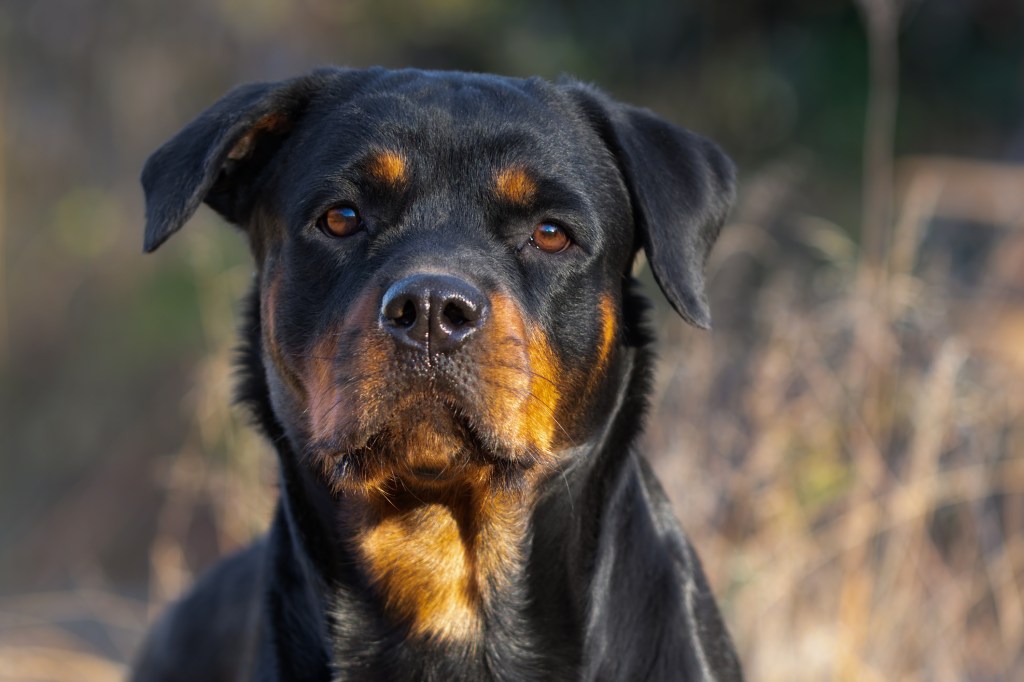
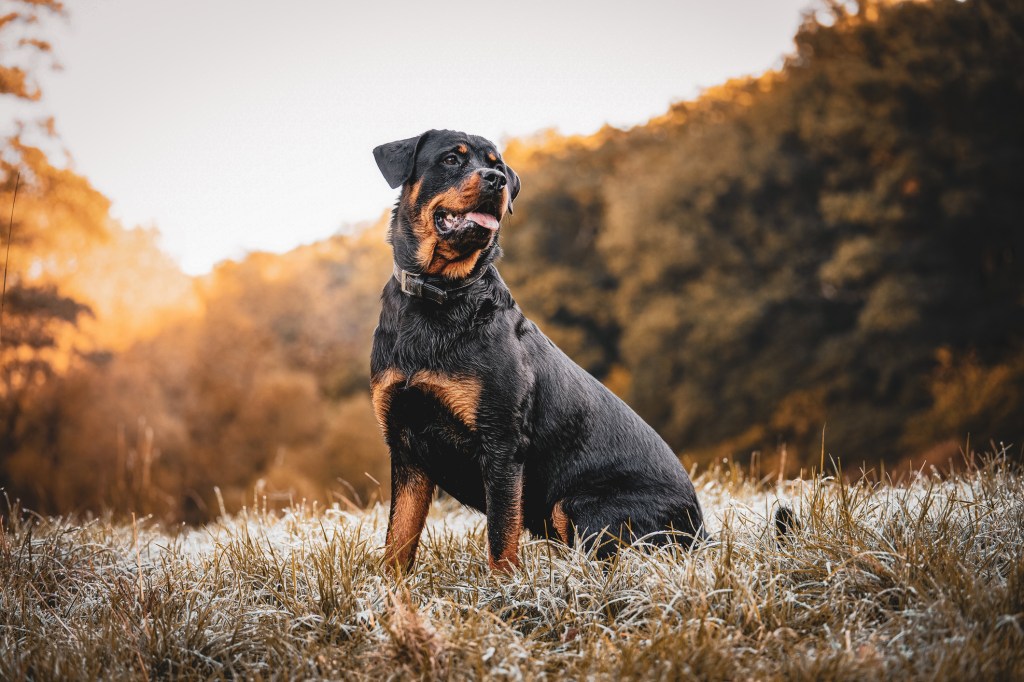

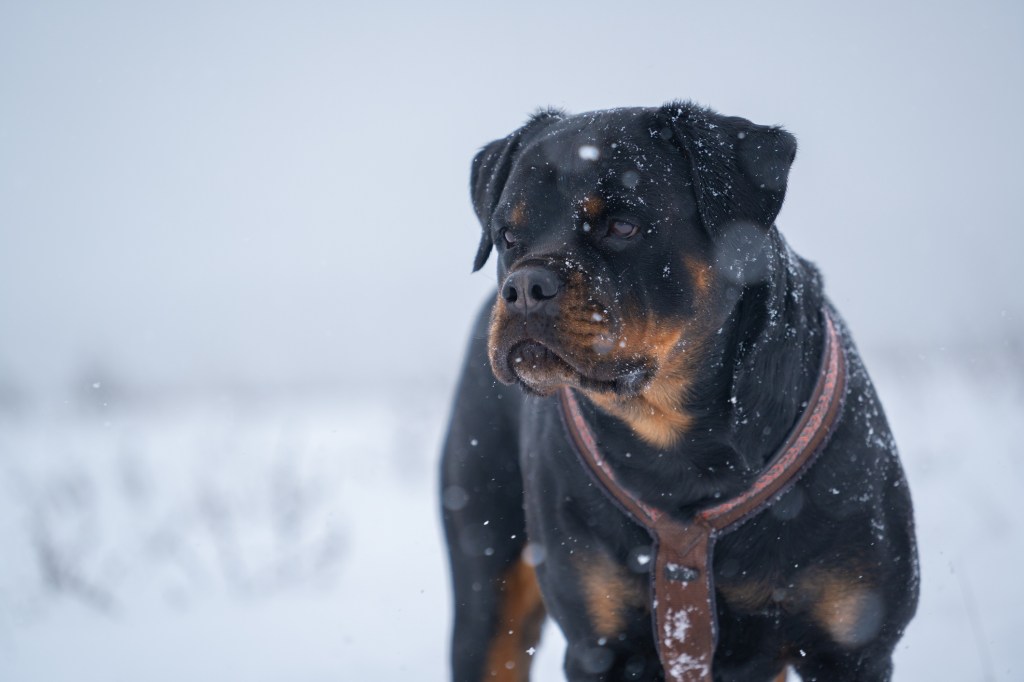
Adaptability
★ ★ ★ ★ ★
All-around friendliness
★ ★ ★ ★ ★
Health And Grooming Needs
★ ★ ★ ★ ★
Trainability
★ ★ ★ ★ ★
Exercise needs
★ ★ ★ ★ ★
Rottweiler Overview
The Rottweiler, often known as a Rottie or Rott, is a breed rich in history and character. Originating from Germany, this breed was utilized by farmers and butchers to herd cattle and pull carts, making them incredibly strong and durable. Their muscular physique is still prominent today, as is their stamina. However, if one were to gaze into their eyes, they’d notice warm, dark eyes full of alertness, intelligence, and a fearless demeanor.
A Rottweiler of sound lineage is a creature of confidence and tranquility. They’re generally reserved around strangers rather than being fearful or timid. This breed is known for their ‘wait-and-see’ approach when faced with new situations or individuals. When nurtured and bred correctly, a Rottweiler quickly becomes a reliable guard dog. They possess a formidable devotion to their family, and their protective instincts can be incredibly fierce. To harness their strength and protective nature, it’s crucial to integrate early socialization, fair, firm, consistent training, and regular tasks into their routine.
Without these elements, a Rottweiler can become an aggressive bully rather than the friendly guardian they’re intended to be. The line between apprehension and hostility can be thin, especially if the breeding didn’t prioritize a calm, intelligent temperament or if proper training and socialization were lacking, leading to over-protectiveness.
Rottweilers are powerful and intelligent dogs who trust and respect their leaders. However, without a calm and confident leader, a Rottweiler may attempt to take on a dominant role, creating potential issues. Despite misconceptions, well-raised Rottweilers are neither unstable nor inherently aggressive. In fact, they’re playful, gentle, and loving creatures.
They are easy to train if given respectful treatment and become great companions. Rottweilers, wonderful as they may be, aren’t suitable for everyone. Owning a Rottweiler involves dedication to its training and socialization, plus dealing with misconceptions about the breed. Some cities have even banned Rottweilers because of past incidents related to them or other large breeds.
It’s crucial not to generalize an entire breed based on these cases. As a Rottweiler owner, strive to train your dog to be obedient and respectful to offset such prejudices. Keep in mind; Rottweilers are extremely loyal and want to be around their human family. Providing the right guidance and structure results in an incredibly rewarding companionship with this breed.
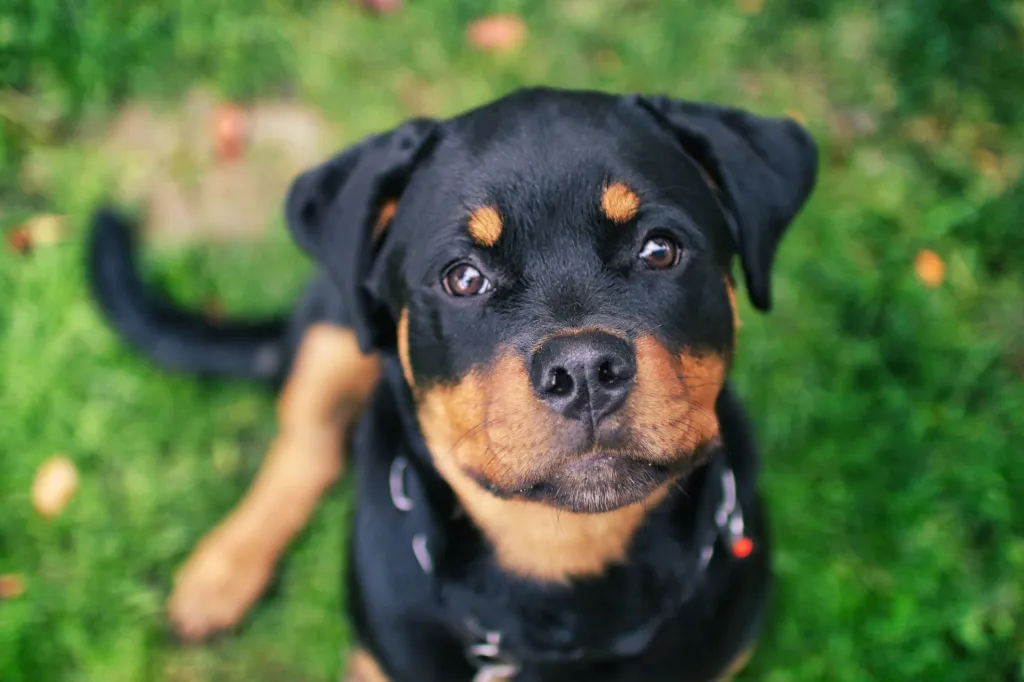
Rottweiler Highlights
- Rottweilers are large, powerful dogs and require extensive socialization and training from early puppyhood. Even if you train and socialize your Rottweiler, expect to be subjected to sometimes unfair advance judgments about your dog, maybe even having untrue allegations made about him and his activities, by those who fear him.
- Because of the current prejudice against dogs such as Rottweilers and claims that they can be dangerous, you may have to carry extra liability insurance to own one, depending upon the ordinances in your town. In some areas, you may not even be able to own a Rottweiler, or may be forced to give up any that you have.
- Rottweilers love people and want to be with their families. If they are left alone for long periods of time or don’t receive adequate exercise, they may become destructive.
- If raised with children, well-bred Rottweilers get along fine with them. They must be taught, however, what is acceptable behavior with children. Rotties have a natural instinct to herd and may “bump” children to herd them. Because of their size, this “bump” may cause toddlers to fall down and injure themselves.
- In addition, some Rottweilers have a strong prey drive and may get overly excited when children run and play. Always supervise your Rottweiler when he’s around children.
- If you have an adult Rottweiler, introduce new animals, especially dogs, carefully. Rottweilers can be aggressive toward strange dogs, particularly those of the same sex. Under your leadership, however, your Rottie will probably learn to coexist peacefully with his new companion.
- Rottweilers are intelligent and are highly trainable if you’re firm and consistent.
- Rottweilers will test you to see if you really mean what you say. Be specific in what you ask, and don’t leave any loopholes for them to exploit. Rottweilers require a couple of 10- to 20-minute walks or playtimes daily.
- Rottweilers have a double coat and shed heavily in the spring and the fall, moderately throughout the rest of the year. Many Rottweilers snore.
- If their food intake is not monitored, Rotties have a tendency to overeat and can gain weight. To get a healthy dog, never buy a puppy from an irresponsible breeder, puppy mill, or pet store. Look for a reputable breeder who tests her breeding dogs to make sure they’re free of genetic diseases that they might pass onto the puppies, and that they have sound temperaments.
Rottweiler History
Rottweilers descend from the Molossus, a mastiff-type dog. Their ancestors marched to Germany with the Romans, driving the cattle that sustained them as they conquered the known world. As the army traveled, the big dogs mated with dogs that were native to the areas they passed through and laid the foundation for new breeds.
One of the areas through which they passed was southern Germany, where the Romans set up colonies to take advantage of climate and soil, which were suitable for agriculture. They built villas roofed with red tile. More than 600 years later, as they were building a new church, inhabitants of the town excavated the site of the ancient Roman baths and uncovered one of the red-tiled villas.
The discovery inspired a new name for the town: das Rote Wil (the red tile). Over the centuries, Rottweilers flourished as a market area for cattle, the German equivalent of a Texas cowtown, and the descendants of the Roman Molossus dogs drove the cattle to town for butchering. To keep their money safe from thieves after selling their livestock, the cattlemen put their filled purses around their Rottweiler’s neck when they returned home. Butchers in the area also used the dogs to pull carts loaded with meat.
Eventually, rail transport replaced cattle drives. The Rottweiler nearly became extinct. At a dog show in Heilbronn, Germany, in 1882, only one nondescript Rottweiler was exhibited. That situation began to change in 1901, when the Rottweiler and Leonberger Club was founded and the first Rottweiler breed standard was written. The description of the Rottweiler’s appearance and character has changed little since then. Rottweilers began to be used in police work, for which they were well suited. Several Rottweiler breed clubs were formed over the years, but the one with staying power was the Allgemeiner Deutscher Rottweiler Klub (ADRK), founded in 1921. The ADRK survived World War II and has continued to promote good breeding programs in Germany and throughout the world.
It’s dedicated to preserving the working ability of the Rottweiler. It’s thought that the first Rottweiler came to the U.S. with a German emigrant in the late 1920s. The first litter was whelped in 1930, and the first dog registered by the American Kennel Club was Stina v Felsenmeer in 1931. After World War II, the breed started becoming more popular. At that time, it was primarily known as an excellent obedience dog. The height of the Rottweiler’s popularity was in the mid-1990s when more than 100,000 were registered with the American Kennel Club.
Being popular isn’t necessarily a good thing when you’re a dog. It’s not unusual for irresponsible breeders and puppy mills to try to cash in on the popularity of a breed and start producing puppies without regard for health and temperament problems. This is what happened to the Rottweiler breed until bad publicity and the demand for them decreased. Dedicated, reputable breeders are taking this chance to turn the breed around and ensure that Rottweilers are the type of dogs they were meant to be. Today, Rottweilers rank 17th among the 155 breeds and varieties registered by the AKC.
Rottweiler Size
Males typically are 24 to 27 inches tall at the shoulder and weigh 95 to 130 pounds. Females typically are 22 to 25 inches tall at the shoulder and weigh 85 to 115 pounds.
Rottweiler Personality
The ideal Rottweiler is calm, confident, and courageous, never shy. He has a self-assured aloofness and doesn’t make friends with people immediately or indiscriminately. Instead, he takes a wait-and-see attitude with new people or situations. With his family, he’s affectionate, often following them around the house. This is not a highly excitable dog. He has an inherent desire to protect his family and property, but should never be aggressive toward people without cause.
The Rottweiler is smart and adaptable with a strong work ethic. You’ll see some differences between the sexes. Males are quiet but watchful, constantly assessing their surroundings for threats. Females are somewhat easier to control and may be more affectionate. Both are highly trainable but can be stubborn. Rottweilers require firm, consistent but not harsh discipline. A sharp word is often a sufficient reprimand, but only if you’ve clearly established your leadership. If not, he may try to bully or bluff you.
This is not a dog for people who lack assertiveness or don’t have time to devote to training and supervision. Earning a Rottweiler’s respect involves setting boundaries and teaching consequences for inappropriate behavior, both of which take time and patience. Temperament is affected by a number of factors, including heredity, training, and socialization. Puppies with nice temperaments are curious and playful, willing to approach people and be held by them. Choose the middle-of-the-road puppy, not the one who’s beating up his littermates or the one who’s hiding in the corner.
Always meet at least one of the parents — usually the mother is the one who’s available — to ensure that they have nice temperaments that you’re comfortable with. Meeting siblings or other relatives of the parents is also helpful for evaluating what a puppy will be like when he grows up. Like every dog, Rotties need early socialization — exposure to many different people, sights, sounds, and experiences — when they’re young. Socialization helps ensure that your Rottweiler puppy grows up to be a well-rounded dog.
Enrolling him in a puppy kindergarten class is a great start. Inviting visitors over regularly, and taking him to busy parks, stores that allow dogs, and on leisurely strolls to meet neighbors will also help him polish his social skills.
Rottweiler Health
Rottweilers are generally healthy, but like all breeds, they’re prone to certain health conditions. Not all Rotties will get any or all of these diseases, but it’s important to be aware of them if you’re considering this breed. If you’re buying a puppy, find a good breeder who will show you health clearances for both your puppy’s parents. Health clearances prove that a dog has been tested for and cleared of a particular condition.
In Rotties, you should expect to see health clearances from the Orthopedic Foundation for Animals (OFA) for hip dysplasia (with a score of fair or better), elbow dysplasia, hypothyroidism, and von Willebrand’s disease; from Auburn University for thrombopathia; and from the Canine Eye Registry Foundation (CERF) certifying that eyes are normal. You can confirm health clearances by checking the OFA web site (offa.org).
- Hip Dysplasia: This is a heritable condition in which the thighbone doesn’t fit snugly into the hip joint. Some dogs show pain and lameness on one or both rear legs, but you may not notice any signs of discomfort in a dog with hip dysplasia. As the dog ages, arthritis can develop. X-ray screening for hip dysplasia is done by the Orthopedic Foundation for Animals or the University of Pennsylvania Hip Improvement Program (PennHIP). Dogs with hip dysplasia should not be bred. If you’re buying a puppy, ask the breeder for proof that the parents have been tested for hip dysplasia and are free of problems. Hip dysplasia is hereditary, but it can be worsened by environmental factors, such as rapid growth from a high-calorie diet or injuries incurred from jumping or falling on slick floors.
- Elbow Dyplasia: Elbow dysplasia is a hereditary malformation of the elbow joint. The severity of the dysplasia can only be determined by x-rays. Your vet may recommend surgery to correct the problem, or medication to control the pain.
- Aortic Stenosis/Sub-aortic Stenosis (AS/SAS): This common heart defect is sometimes seen in Rottweilers. The aorta narrows below the aortic valve, forcing the heart to work harder to supply blood to the body. This condition can cause fainting and even sudden death. It’s an inherited condition, but its mode of transmission isn’t known at this time. Typically, a veterinary cardiologist diagnoses this condition after a heart murmur has been detected.
- Osteosarcoma: Generally affecting large and giant breeds, osteosarcoma is an aggressive bone cancer. The first sign of osteosarcoma is lameness, but the dog will need x-rays to determine if the cause is cancer. Osteosarcoma is treated aggressively, usually with the amputation of the limb and chemotherapy. With treatment, dogs can live nine months to two years or more. Luckily, dogs adapt well to life on three legs and don’t suffer the same side effects to chemotherapy as humans, such as nausea and hair loss.
- Gastric Dilatation-volvulus (GDV), also called Bloat or Torsion: This is a life-threatening condition that can affect large, deep-chested dogs like Rottweilers, especially if they are fed one large meal a day, eat rapidly, drink large volumes of water after eating, and exercise vigorously after eating. Some think that raised feeder and type of food might be a factor in causing this to happen too. It is more common among older dogs. GDV occurs when the stomach is distended with gas or air and then twists (torsion). The dog is unable to belch or vomit to rid itself of the excess air in its stomach, and the normal return of blood to the heart is impeded. Blood pressure drops and the dog goes into shock. Without immediate medical attention, the dog can die. Suspect bloat if your dog has a distended abdomen, is salivating excessively and retching without throwing up. He also may be restless, depressed, lethargic, and weak with a rapid heart rate. It’s important to get your dog to the vet as soon as possible.
- Panosteitis (Pano): This is sometimes referred to as “growing pains” because it usually occurs in puppies when they are around four months old. The primary symptom is lameness. Often, rest will be all that is needed, but if your puppy starts limping, it’s a good idea to have your vet check him.
- Hypothyroidism: Hypothyroidism is caused by a deficiency of thyroid hormone and may produce signs that include infertility, obesity, mental dullness, and lack of energy. The dog’s fur may become coarse and brittle and begin to fall out, while the skin becomes tough and dark. Hypothyroidism can be managed very well with a thyroid replacement pill daily. Medication must continue throughout the dog’s life.
- Allergies: Allergies are a common ailment in dogs. Allergies to certain foods are identified and treated by eliminating certain foods from the dog’s diet until the culprit is discovered. Contact allergies are caused by a reaction to something that touches the dog, such as bedding, flea powders, dog shampoos, or other chemicals. They are treated by identifying and removing the cause of the allergy. Inhalant allergies are caused by airborne allergens such as pollen, dust, and mildew. The appropriate medication for inhalant allergies depends on the severity of the allergy. Ear infections are a common side effect of inhalant allergies.
Regardless of how healthy your dog is when you first bring them home, you should prepare for any issues that may come up throughout their life. A pet insurance plan can help you stay ready for any of your dog’s veterinary needs.
Rottweiler Care
It’s important for Rottweilers to live in the home with their people. If they’re left alone in a backyard all the time, they can become bored, destructive, and aggressive. Although they’re large, Rottweilers are inactive indoors. A Rottweiler is a homebody, but he requires a fenced yard not only to protect him from traffic but also because he can be aggressive toward other dogs and strangers who come onto his property.
An underground electronic fence can’t keep your Rottie in your yard if he really wants to get out. More important, it doesn’t prevent people or other animals from coming onto your property. Put up a sign advising strangers and non-family members not to come onto your property without your escort. The Rottweiler’s energy level ranges from couch potato to whirlwind. Be sure to tell the breeder what kind of energy level suits you so she can help you choose the best puppy for your lifestyle. Moderately active Rottweilers will appreciate a couple of 10- to 20-minute walks each day.
They also enjoy playing with balls and going hiking. More energetic Rotties may need longer exercise times and more structured activities. Their athleticism, intelligence, and trainability make them well suited to agility and obedience competition, as well as tracking, therapy work, and their traditional job, pulling a cart or wagon. Perfect for parades! When training your Rottweiler, keep in mind that he thrives on mental stimulation. He likes to learn new things and is eager to please you. He might be willful at times, with a “Show me why I should do this” attitude. Be fair, consistent, and firm, and your Rottweiler will reward you with his quick ability to learn. Your Rottweiler shouldn’t be difficult to housetrain given a consistent schedule, no opportunities to have accidents in the house, and positive reinforcement when he potties outdoors.
Rottweiler Feeding
Recommended daily amount: 4 to 10 cups of high-quality dry food a day, divided into two meals. Note: How much your adult dog eats depends on his size, age, build, metabolism, and activity level. Dogs are individuals, just like people, and they don’t all need the same amount of food. It almost goes without saying that a highly active dog will need more than a couch potato dog.
The quality of dog food you buy also makes a difference — the better the dog food, the further it will go toward nourishing your dog and the less of it you’ll need to shake into your dog’s bowl. Keep your Rottweiler in good shape by measuring his food and feeding him twice a day rather than leaving food out all the time. If you’re unsure whether he’s overweight, give him the eye test and the hands-on test. First, look down at him. You should be able to see a waist.
Then place your hands on his back, thumbs along the spine, with the fingers spread downward. You should be able to feel but not see his ribs without having to press hard. If you can’t, he needs less food and more exercise. For more on feeding your Rottie, see our guidelines for buying the right food, feeding your puppy, and feeding your adult dog.
Rottweiler Coat Color And Grooming
Rottweilers have a short double coat that’s straight and coarse. The outer coat is medium in length, shorter on the head, ears, and legs; the undercoat is found mainly on the neck and thighs. The amount of undercoat your Rottie has depends on the climate in which he lives. The Rottweiler is always black with markings that are rust to mahogany in color. The markings appear over the eyes, on the cheeks, on each side of the muzzle, on the chest and legs, and beneath the tail.
There are also tan lines that resemble pencil marks on the toes. Brush your Rottie weekly with a firm bristle brush to remove dead hair and distribute skin oils. He’ll shed twice a year, and you’ll probably want to brush more frequently during that time to keep the loose hair under control. Bathe him as needed. If you bathe him outdoors, it should be warm enough that you’re comfortable without wearing long sleeves or a coat. If you aren’t, it’s too cold to be giving your Rottie a bath out there. Brush your Rottie’s teeth at least two or three times a week to remove tartar buildup and the bacteria that lurk inside it. Daily brushing is even better if you want to prevent gum disease and bad breath.
Begin accustoming your Rottweiler to being brushed and examined when he’s a puppy. Handle his paws frequently — dogs are touchy about their feet — and look inside his mouth and ears. Make grooming a positive experience filled with praise and rewards, and you’ll lay the groundwork for easy veterinary exams and other handling when he’s an adult.
Rottweiler Children And Other Pets
Rottweilers typically like children, especially if they’re raised with them. When around children, especially young ones, they should be supervised because they are so big and strong. Because of their cattle-driving heritage, they have a tendency to lean and push and can accidentally topple a toddler with a nudge.
They’re probably best suited to homes with older children who understand how to interact with dogs. It’s also important to supervise your Rottweiler any time your children have friends over. Rotties can be perturbed by loud or rough play between kids and may take steps to put a stop to it, not understanding that “his” children aren’t in danger. They may also chase young children who are running. Always teach children how to approach and touch dogs, and always supervise any interactions between dogs and young children to prevent any biting or ear or tail pulling on the part of either party.
Teach your child never to approach any dog while he’s sleeping or eating or to try to take the dog’s food away. No dog should ever be left unsupervised with a child. When Rottweilers are raised with other dogs and cats, they generally get along well with them. They may have issues with strange dogs or adult dogs that are introduced into the home, being intolerant of same-sex dogs. With your training and guidance, however, they should accept new animals peaceably. Keep your Rottie on leash in public to prevent aggression or belligerence toward other dogs. The Rottie is not the best candidate for visiting off-leash dog parks.
Rottweiler Rescue Groups
Rottweilers are often purchased without any clear understanding of what goes into owning one. There are many Rotties in need of adoption and or fostering. There are a number of rescues that we have not listed. If you don’t see a rescue listed for your area, contact the national breed club or a local breed club and they can point you toward a Rottie rescue.
All dogs will need veterinary care at some point in their lives. When you adopt, make sure you’re prepared to address any health issues that may come up after you leave the shelter. A pet insurance plan can keep your dog covered.
Rottweiler Breed Organizations
Finding a reputable dog breeder is one of the most important decisions you will make when bringing a new dog into your life. Reputable breeders are committed to breeding healthy, well-socialized puppies that will make great companions. They will screen their breeding stock for health problems, socialize their puppies from a young age, and provide you with lifetime support.
On the other hand, backyard breeders are more interested in making a profit than in producing healthy, well-adjusted dogs. They may not screen their breeding stock for health problems, and they may not socialize their puppies properly. As a result, puppies from backyard breeders are more likely to have health problems and behavioral issues.